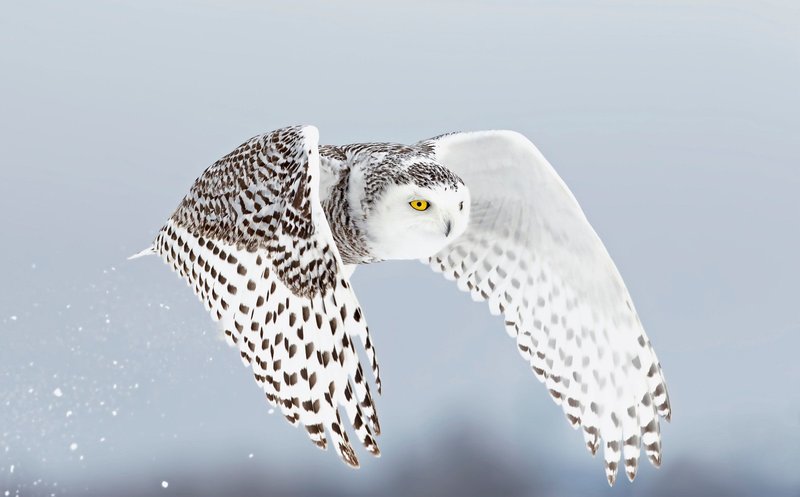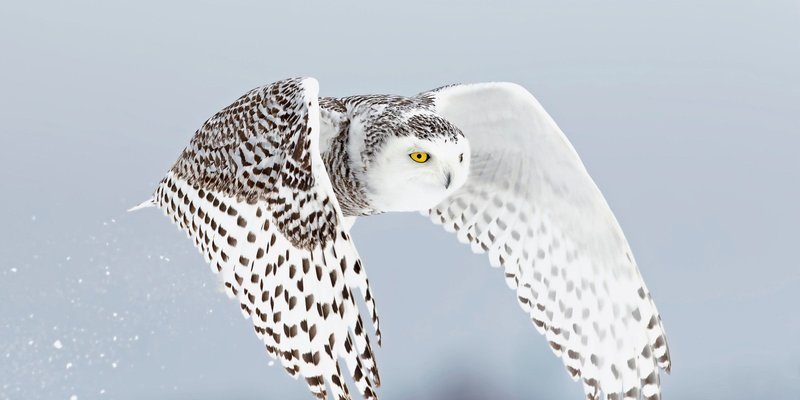
Now, you might be wondering how exactly these remarkable birds manage to do it. Here’s the thing: snowy owls don’t just survive; they thrive by adapting to their environment in a variety of clever ways. Let’s dive into the unique features and behaviors that help these exquisite creatures maneuver through their icy homes.
The Snowy Owl’s Stunning Appearance
One of the most striking features of snowy owls is their white plumage, which not only looks beautiful but serves a critical purpose. Their feathers are thick and fluffy, providing excellent insulation against the frigid temperatures of the Arctic. This is similar to how wearing a heavy winter coat keeps you warm when you step outside in the snow.
The snowy owl’s white coloration also helps them blend into their surroundings, acting like a natural camouflage. You might say they’re the ultimate hide-and-seek champions! This invisibility against the white snow allows them to ambush unsuspecting prey, primarily small mammals like lemmings. In short, their appearance is not just for show; it’s a multi-purpose adaptation that enhances their survival.
But here’s what’s really interesting: during the summer months, their feathers can take on a more mottled look, featuring dark spots. This change helps them stay hidden among the rocks and grasses of the tundra. It’s like having a wardrobe that changes with the seasons.
Masterful Hunting Techniques
Let’s get to the good stuff—the way snowy owls hunt. These birds are equipped with powerful talons and exceptional eyesight. Picture this: they can spot a lemming from a mile away, even in the dim light of dawn. Honestly, that’s some superhero-level vision!
When hunting, snowy owls often sit patiently on a perch, scanning the ground for movement. This behavior is similar to how someone might wait for the perfect wave while surfing. Once they see their target, they swoop down silently, using their incredible wings to glide smoothly without making a sound.
This stealthy approach is combined with their ability to hunt both during the day and at night. Unlike many birds that might restrict their hunting to twilight, snowy owls can adapt to different light conditions, allowing them to take advantage of the long summer days and catch prey when it’s most active. It’s all about maximizing their opportunities!
Diet and Nutritional Adaptations
Speaking of hunting, let’s talk about what snowy owls eat. Their primary diet is made up of small mammals, especially lemmings. But here’s the thing: they can adjust their diet based on availability. If lemmings are scarce, snowy owls can switch to birds, rabbits, or even fish. This flexibility is crucial for their survival in changing environments.
The snowy owl’s hunting strategy is influenced by its incredible ability to detect prey. They have excellent hearing, which helps them locate animals even beneath snow cover. Imagine trying to find a friend in a crowded café—you’d listen for their voice. Like that, the snowy owl listens for the sounds of its next meal rustling in the snow.
The snowy owl can consume large quantities of food in one sitting, which is vital during the breeding season when they need to gather extra energy for their chicks. A well-fed snowy owl can be quite the powerhouse, capable of flying long distances in search of food.
Breeding and Nesting Behaviors
When it comes to raising their young, snowy owls exhibit fascinating behaviors that show how well they adapt to their environment. They typically nest on the ground in simple scrapes rather than building elaborate nests. Think of it like choosing a cozy corner in a room rather than a whole bedroom. The simplicity allows them to make quick decisions about where to raise their young without the fuss.
During the breeding season, snowy owls can be quite territorial. They defend their nesting area against other owls and sometimes even larger birds. This behavior ensures that they have enough food to feed their chicks and maintain a stable environment for their growing young. It’s a bit like securing your favorite spot at the beach—wanting to keep that little piece of paradise all to yourself.
After laying eggs, the female snowy owl incubates them for about 30 days, while the male provides food. Once the chicks hatch, both parents continue to care for them until they’re ready to fledge. This teamwork is vital, as raising young owls in the harsh Arctic requires cooperation and shared responsibilities.
Weathering the Arctic Climate
Living in the Arctic isn’t just about cold temperatures; it also involves unpredictable weather. Snowy owls are equipped to handle these extreme conditions. For instance, their thick feathers not only keep them warm but also repel moisture, preventing them from getting cold and wet in the snow.
Moreover, they have a special layer of skin that helps keep them insulated. Think of it like having a built-in heating system that kicks in when temperatures drop. This adaptation is essential for providing warmth during relentless blizzards and chilling winds.
Additionally, snowy owls are able to tolerate long periods of darkness during winter. Their bodies have adapted to maximize their energy usage, enabling them to thrive despite the lack of sunlight. It’s a bit like how we might adjust our routines to get used to daylight savings time. They manage to find a way to make it work.
The Importance of Migration
While snowy owls are residents of the Arctic, they exhibit a fascinating behavior known as irruption. This is when they migrate to areas far from their usual habitat due to food scarcity, particularly when lemming populations fall. Imagine going on a road trip to find the best pizza in town—snowy owls do something similar, seeking better feeding grounds.
During these migrations, they can travel hundreds of miles, venturing south into Canada and even parts of the northern United States. This adaptability not only ensures their survival but also highlights their role in the ecosystem. By spreading out, they help manage local rodent populations, which is a win-win for everyone involved.
However, migration comes with its own challenges. Changing weather patterns can affect their travel routes and food sources. Understanding these patterns is crucial for conservation efforts and ensuring snowy owls continue to thrive in the wild.
Conservation and Human Impact
Like many other species, snowy owls face threats from habitat loss and climate change. As the Arctic warms, their environment is changing rapidly. You might be surprised to learn that melted ice and changing landscapes can impact their hunting and breeding grounds, leading to increased vulnerability.
Conservation efforts are underway to protect these magnificent birds and their habitats. Organizations are working to monitor populations and raise awareness about the importance of preserving the Arctic ecosystem. After all, maintaining healthy environments is key not just for snowy owls, but for countless other species that share their home.
By promoting coexistence and understanding between human activities and wildlife, we can help ensure that snowy owls continue to soar across the Arctic sky for generations to come.
In summary, snowy owls are incredible adaptors, showcasing nature’s ability to thrive even in the harshest of climates. From their hunting strategies to their breeding habits, every aspect of their life is a testament to their resilience. So next time you think of snowy owls, remember just how well these magnificent birds have adapted to their icy world!

